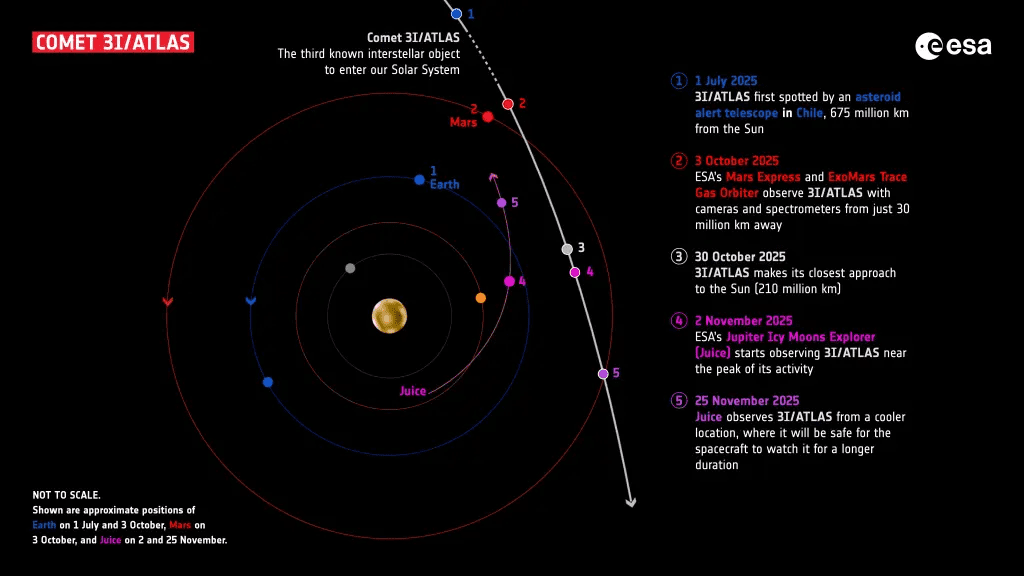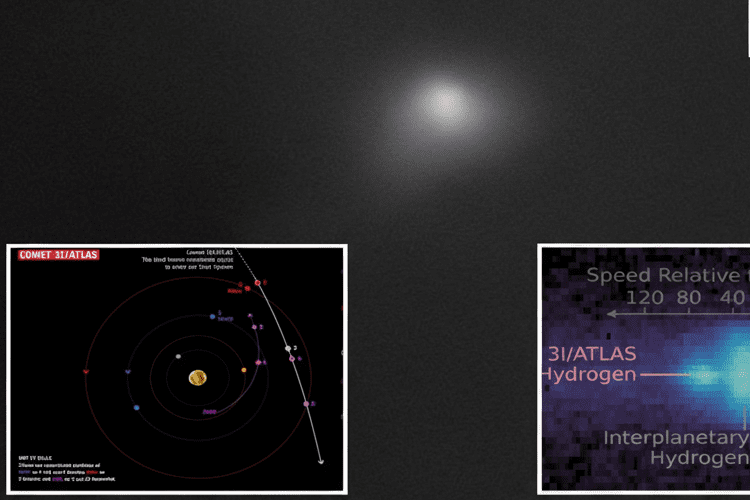From Alien Skies to Earth’s Doorstep: The Jaw-Dropping High-Res Reveal of Interstellar Comet 3I/ATLAS That Has Scientists Whispering About Life’s Wildest Secrets—and Why It’s Hurtling Toward Us at Breakneck Speed
Under the vast, star-strewn canopy of a Hawaiian night sky, where the trade winds whisper secrets older than time itself, a team of astronomers at the University of Hawaii’s ATLAS observatory huddled around glowing monitors, their breaths catching as pixels coalesced into something utterly otherworldly. It was July 2025, and what began as a routine sweep for near-Earth threats had unveiled a wanderer from the cosmic deeps—a Manhattan-sized interloper named 3I/ATLAS, the third confirmed visitor from beyond our solar system, slicing through the void at a blistering 153,000 miles per hour. Fast-forward to November 19, 2025, and NASA has unveiled breathtaking high-resolution images that transform this celestial drifter from a distant speck into a hazy, ethereal marvel: a glowing orb wreathed in a coma of gas and dust, trailing a faint tail like a comet’s sigh, captured against the crimson backdrop of Mars. As the world pauses amid earthly headlines to gaze upward, these portraits stir a profound ache in the human heart—a reminder that in our fragile blue marble, we are but momentary guests to the universe’s grand, indifferent ballet, forever chasing echoes of worlds we’ll never touch.

The discovery of 3I/ATLAS wasn’t born of fanfare or fireworks, but of the quiet vigilance that defines humanity’s quest to understand the stars. The Asteroid Terrestrial-impact Last Alert System, or ATLAS, a network of telescopes scattered across Hawaii and Chile like watchful sentinels, exists to guard against doomsday rocks—those silent assassins that could rewrite our story in an instant. On that fateful July evening, as data streamed in from the Haleakala summit, algorithms flagged an anomaly: an object tumbling erratically, its trajectory screaming “not from here.” Unlike the predictable orbits of our solar system’s children, this one barreled in on a hyperbolic path, slingshotting past the sun with the reckless speed of a bullet from another galaxy. “It was like spotting a ghost in the machine,” recalls Larry Denneau, ATLAS project manager, his voice still laced with the thrill of that midnight breakthrough during a recent interview from his Honolulu office, where posters of ‘Oumuamua—the first interstellar scout spotted in 2017—adorn the walls like family portraits. Within hours, confirmations poured in from global observatories, dubbing it 3I/ATLAS in honor of its ATLAS birthplace, a nod to the two predecessors that had already ignited imaginations: the enigmatic cigar-shaped ‘Oumuamua, which sparked wild theories of alien tech, and the more demure comet 2I/Borisov, a fleeting brush with icy elegance in 2019.
What makes 3I/ATLAS a heart-stirring enigma is its sheer, improbable scale and solitude—a rogue roughly the size of Manhattan, some 10 to 20 miles across, hurtling through the emptiness at velocities that dwarf our fastest rockets. Born perhaps in the turbulent nurseries of another star system billions of years ago, it was ejected by gravitational mayhem, condemned to an eternal exile among the stars until gravity’s gentle tug drew it into our neighborhood. NASA’s new images, released after a brief delay from the government’s recent shutdown that ended just the week prior, peel back the veil with unprecedented clarity, thanks to a serendipitous alignment of spacecraft eyes. The Psyche Mission, en route to a distant metal asteroid but pausing for this cosmic detour, snapped four exquisite frames over eight hours on September 8 and 9 from a vantage of 33 million miles away. There, against the black canvas, emerges the object’s nucleus: a faint, fuzzy core no larger than a pixel storm, encircled by a diaphanous coma—a hazy envelope of sublimating gases and dust particles, glowing softly as solar winds sculpt it into ephemeral art. “It’s like watching a dancer caught mid-twirl,” says Tom Statler, NASA’s lead scientist for solar system small bodies, his words evoking the poetry of physics during a briefing where the images flickered on screens like living dreams. Stacked exposures from the Lucy Mission, gazing from 240 million miles out, reveal the tail—a wispy streamer stretching miles, a frozen vapor trail etched by the sun’s relentless kiss.

Perhaps the most mesmerizing vista comes from Mars itself, where the Red Planet’s unblinking watchers turned skyward in October 2025, during 3I/ATLAS’s closest shave with the rusty world at a mere 28 million miles. The Mars Reconnaissance Orbiter’s HiRISE camera, a high-res marvel designed for Martian canyons, pivoted to capture the intruder in ultraviolet splendor: a composite image blooming with hydrogen atoms, their azure glow a spectral fingerprint of outgassed volatiles from the object’s ancient heart. Down on the surface, the Perseverance rover—NASA’s tireless trailblazer in Jezero Crater—tilted its mast camera upward, joining the fray with grainy but poignant snaps that place the visitor in context against the thin Martian horizon. These weren’t planned portraits; they were gifts of geometry, a rare cosmic conga line where probes built for one mission moonlighted as interstellar paparazzi. “It’s as if we threw a party and the universe RSVP’d with front-row seats,” quips Nicky Fox, NASA’s associate administrator for the Science Mission Directorate, her enthusiasm bubbling over in a NASA livestream that drew millions, families huddled on couches from Seattle suburbs to Sydney backyards, sharing the awe of something truly alien brushing our doorstep.
At its core—pun intended—3I/ATLAS behaves like a comet straight out of our own backyard: icy ices vaporizing under sunlight, birthing that coma and tail in a display of stellar alchemy. Yet its interstellar pedigree sets it apart, a pristine time capsule untainted by billions of years orbiting the sun, offering scientists a window into the building blocks of distant worlds. Amit Kshatriya, NASA’s Associate Administrator for Exploration Technology, captures the electric tension in his assessment: “All the evidence we have so far supports that it’s a comet—how it looks, how it behaves—but its origin outside our solar system makes it scientifically invaluable.” Spectrographic data, gleaned from ground-based telescopes like the Very Large Telescope in Chile, hint at familiar suspects: water ice, carbon dioxide, perhaps exotic organics that whisper of life’s primordial soup. No signs of artificiality here, despite the echoes of ‘Oumuamua’s non-gravitational nudges that once fueled sci-fi speculation; 3I/ATLAS follows Newtonian rules to the letter, a natural nomad reinforcing the galaxy’s indifference to our wonder. Still, the emotional pull is undeniable—imagine the silent eons this wanderer endured, flung from a stellar nursery, adrift in the cold until our telescopes caught its gleam, like a message in a bottle washing up on cosmic shores.

This revelation arrives at a poignant juncture for space exploration, a field buoyed by NASA’s Artemis ambitions and private pioneers like SpaceX, yet haunted by the fragility of funding and focus. The images’ release, delayed by the shutdown’s bureaucratic snarl—a mere week of furloughs that idled civil servants but couldn’t dim the stars—underscores the human endeavor behind the pixels: teams of engineers at Lockheed Martin tweaking instruments on the fly, astronomers in Pasadena’s Jet Propulsion Laboratory burning midnight oil to process data streams. Nearly 20 mission operations centers worldwide contributed, from the European Space Agency’s contributions to Japan’s Akatsuki orbiter peeking from Venusian orbit, a global chorus harmonizing in pursuit of the unknown. “These views are like seats at a baseball game from every angle in the stadium,” Statler adds, his analogy grounding the ethereal in the everyday, inviting armchair stargazers to feel the thrill of discovery without leaving their decks. For young dreamers—kids in rural Montana peering through backyard scopes or urban teens coding simulations in Brooklyn bedrooms—these images ignite that spark, a reminder that the universe isn’t a textbook but a living tapestry, woven with threads we can touch through science’s steady hand.
Comparisons to its interstellar siblings only heighten the drama. ‘Oumuamua, the ruddy, rocky enigma that zipped through in 2017 at 196,000 mph, left us pondering its tumbling asymmetry and unexplained acceleration, a puzzle that birthed books and bedtime theories. Borisov, the blue-hued comet of 2019, was more obliging—a gassy giant with cyanide traces that echoed our own comets, yet its hyperbolic haste marked it as an exile. 3I/ATLAS threads the needle: cometary flair with the velocity of a galactic hitchhiker, its closest Earth approach on December 19, 2025, at 167 million miles—a cosmic near-miss that outstrips the sun’s distance but dwarfs the void between stars. Amateur astronomers, from the Backyard Worlds project to iTelescope.net users, are already queuing for glimpses, their forums alive with tips on spotting the faint wanderer against Sagittarius’s starry sprawl. “It’s a once-in-a-lifetime event,” urges Karen Meech, the University of Hawaii astronomer who co-discovered ‘Oumuamua and now shepherds 3I/ATLAS studies, her voice warm with mentor’s encouragement in a CNN spot. “Grab your binoculars; this is your chance to connect with something truly from elsewhere.”

As December dawns, with holiday lights mirroring the object’s glow, the scientific frenzy builds toward that perihelion rendezvous. Ground telescopes like the James Webb Space Telescope, diverted from exoplanet hunts, will train infrared eyes on its ices, probing for amino acids or silicates that might hint at life’s extraterrestrial cradle. Airborne observatories, SOFIA’s successor if funded, could catch thermal signatures from afar, while radio arrays like ALMA in Chile eavesdrop on molecular murmurs. The emotional undercurrent runs deep: in an era of division, where earthly woes dominate feeds, 3I/ATLAS offers a unifying gaze upward, a shared breath held in wonder. Families gather under domes, educators weave it into curricula, poets pen odes to the orphan star-child. For the scientists who’ve dedicated lives to these fleeting visits—Meech, with decades charting comets; Statler, bridging policy and passion—the images evoke a tender nostalgia, a love letter from the cosmos that arrives just when we need it most.

In the end, as 3I/ATLAS slingshots onward, bound for the outer dark once more, it leaves us not with answers, but with the exquisite ache of questions unanswered. Is it a harbinger of more to come, as models predict dozens of interstellar passersby per decade? A clue to how our own Oort Cloud flings icy envoys into the galaxy? Or simply a beautiful reminder that we, too, are wanderers—brief, bold, forever reaching? NASA’s gift of these images, sharp as a lover’s glance across a crowded room, invites us all to pause, to feel small yet infinitely connected. On December 19, as it crests closest, step outside; let the night sky swallow you whole. In that moment, amid the hush of winter winds, you’ll hear it: the universe calling, soft as a comet’s tail, urging us to dream a little larger.



